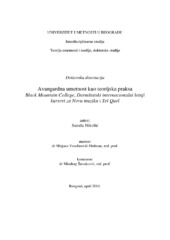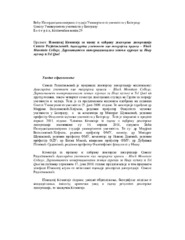| dc.contributor.advisor | Veselinović-Hofman, Mirjana | |
| dc.contributor.other | Popović Srdanović, Dubravka | |
| dc.contributor.other | Daković, Nevena | |
| dc.contributor.other | Mikić, Vesna | |
| dc.creator | Nikolić, Sanela | |
| dc.date.accessioned | 2018-05-30T13:22:34Z | |
| dc.date.available | 2018-05-30T13:22:34Z | |
| dc.date.issued | 2011-12-24 | |
| dc.date.submitted | 2011-06-06 | |
| dc.identifier.uri | http://eteze.arts.bg.ac.rs/handle/123456789/316 | |
| dc.description.abstract | U fokusu istraživanja doktorske disertacije nalazi se problem odnosa između
umetničkog i teorijskog rada u okviru tri avangardna sveta umetnosti – Black
Mountain College-a, Darmštatskih internacionalnih letnjih kurseva za Novu muziku
(Die Internationalen Ferienkurse für Neue Musik Darmstadt) i Tel Quel-a.
Teoretizacija fenomena avangarde sprovedena je primenom koncepta teorijske prakse
kako je on postavljen u diskursu Luja Altisera. Osnovna teza ovog istraživanja
sadržana je u trvrdnjama da je, u odnosu na utvrđene diskurzivne konceptualizacije
umetnosti, svaka avangarda ostvarila efekat teorijske prakse ali i da je teorijski rad
umetnika bio konstitutivan deo mehanizma svake avangarde, zajednički označitelj
međusobno diferentnih avangardnih pojava, te bitan uslov uobličavanja avangarde
kao teorijske prakse i prostora odigravanja svojevrsnih epistemoloških preloma.
U svetu avangardne umetnosti teorijski rad je imao poseban status koji je bio
određen njegovim zastupanjem umetnosti i konkretnog umetničkog rada u procesu, za
avangardu, neophodnog posredovanja izme u umetni kog rada i kulturalnih,
društvenih referenci i pozicija. Avangardno umetničko delo i avangardna umetnička
praksa su zbog svojih posebnosti zahtevali prateća objašnjenja i interpretacije koje su
se iskazivale kao autopoetički spisi ili teorije umetnika. Paralelno stvaranju
umetničkih dela i istraživanju materijala umetnosti, umetnici avangarde su stvarali i
polje napisa o umetnosti koje je delovalo kao preduslov za razumevanje i shvatanje te
‘nove’ umetnosti. Tako su se izvan naučnih, filozofskih i estetičkih kompetencija
mišljenja o umetnosti a unutar individualnih ili grupnih praksi istraživanja (u)
umetnosti formirala pojedina na polja epistemologije umetnosti. Avangardnom
novinom uslovljeni i provocirani pojmovi ‘umetnost’ i ‘teorija’ prestali su da budu
granični i međusobno ‘spoljnje’ odnosni, te su postali delovi ontološki dvojakog, u
umetničkom i teorijskom radu utemeljenog polja umetničke produkcije.
Ukazano je da teorija umetnika nije intencionalno formulisana pre ili prilikom
stvaranja dela, već da umetničko delo nastaje u složenim odnosima razlika sa drugim
delima i tekstovima kulture. Umetničko i teorijsko se uvek konstituišu u intertekstualnom vidu, a sa uspostavljanjem namernih ili slučajnih relacija sa drugim tekstovima (izvan) umetnosti. Kada je u pitanju međusobno uodnošavanje tri
odabrane studije slučaja, odnos između umetničkog i teorijskog rada iskazao se u
promenljivim pojedinačnim relacijama, od teorijske prakse kao teoretizacije umetnosti
do teorijske prakse kao teoretizacije teksta, kulture i društva. Zapravo, primenom
modela intertekstualnosti istaknuto je da avangardno umetničko delo ostvaruje svoje
značenje tek u odnosu sa teorijskim radom umetnika (Black Mountain College,
Darmštat), dok teorijski rad o umetnosti ima potencijal da ostvari iskorak ka
teorijskom tuma enju kulture u celini (Tel Quel).
Odabrani svetovi umetnosti – Black Mountain College, Darmštat i Tel Quel –
ostvarili su smisao avangardne novine ne samo u pogledu prirode umetničkog
materijala, nego i zbog nove uloge i odnosa umetničkog i teorijskog koji se njihovim
radom iskazao i uspostavio. Zato što je umetnička i teorijska svest avangardi bila
usmerena na demonstriranje radikalnih kritičkih zahvata u postojeće umetničko
nasleđe ali i u ideološke kontekstualnosti, avangarde su delovale kao reprezentativni
prostori odigravanja transformacije umetnosti kao stvaranja u umetnost kao praksu.
Ispoljavanje različitih avangardno orijenisanih umetničkih pokreta, od istorijskih
avangardi do postavangardi, značilo je proizvodnju epistemoloških preloma i, u većini
slučajeva, narušavanje paradigme umetnosti kao autonomnog područja ljudske
delatnosti, umetničkog rada kao stvaranja i umetničkog dela kao ’lepog’ predmeta.
Proizvodnost teorije kao društvene prakse je u okviru razmatranih avangardnih
umetničkih svetova bila locirana ne samo u trenutak proizvodnje specifičnog
umetničkog sveta i obezbeđivanja odgovarajućeg statusa umetničkom radu i
umetničkom delu, nego i u trenutak proizvodnje konfrontacija novih i starih saznanja
kada se kao proizvod dobijao novi epistemološki model o umetnosti. Ovo je trajno
promenilo shvatanje odnosa između umetničkog i teorijskog rada, kao i značaj
teorijskog u umetničkom radu, kako u pogledu njihovog potonjeg ispoljavanja u
konkretnoj umetničkoj praksi tako i u različitim tumačenjima umetnosti. Bitna uloga
teorijskog rada u okviru avangardnih svetova umetnosti fundamentalno je promenila
prirodu i smisao rada umetnika kao i odnos između umetnićkog i teorijskog rada u
tokovima razvoja zapadne umetnosti modernog doba. Razmatrani avangardni
umetnički svetovi ispoljili su se kao reprezentativni primeri neophodnih veza i
međusobne zavisnosti umetničkog i teorijskog rada, te uloge teorijskog u
konstituisanju umetničkog. | en |
| dc.description.abstract | In the focus of this doctoral dissertation is the problem of the relationship between the artistic and the theoretical work within the three avant-garde art worlds – Black Mountain College, The International Summer Course for New Music Darmstadt (Die Internationalen Ferienkurse für Neue Musik Darmstadt) and Tel Quel. As formulated in the Louis Althusser’s theoretical discourse, the concept of theoretical practice is used for the consideration of the avant-garde art phenomenon.
The central claims of this doctoral dissertation are that every avant-garde art practice
made the effect of theoretical practice on the discursive set of art conceptualizations
and that artist’s theoretical writings were the constitutive part of every avant-garde art
mechanism, common signifier for different avant-garde art phenomenon and the
substantial element in articulation of the avant-garde as theoretical practice and the
field of distinguishing epistemological breaks enactment.
In the avant-garde art world the theoretical work had a specific status. This
status was determined by the role of theoretical work in the process of, for the avantgarde, necessary mediation between the artistic work and cultural, social references and positions. Because of their specific features, the avant-garde art work and the avant-garde artistic practice demanded the additional explanations and interpretations in the form of auto poetic texts or artist’s theories. Along with the creation of art works and research in the art materials, the avant-garde artists also created the writings about art which were prerequisite for understanding and comprehension of that ‘new’ art. Thus, beyond scientific, philosophical and aesthetics spheres of thinking about art, and within individual or group practices of art research were formed particular fields of epistemology of art. By the avant-garde innovation
conditioned and provoked terms ‘art’ and ‘theory’ stopped to be hierarchically
‘separated’ and became the equally important parts of ontological double-nature, in
the artistic and theoretical work grounded field of artistic production.
It is pointed out that the artist’s theory is not intentionally formulated prior or during the art work creation, but that his work appears within the complex relations of differences between itself and other works and cultural texts. The ‘artistic’ and the ‘theoretical’ are always articulated in the intertextual relations establishing the intended or not intended connections with other texts beyond or within the scope of art. When it comes to the three selected case studies, the relation between artistic and theoretical work appears in different, variable shapes, from the theoretical practice as theorization of art to the theoretical practice as theorization of text, culture and society. Actually, through the use of concept of intertextuality it is emphasized that the avant-garde art work accomplishes its meaning only in relation with the artist’s theory (Black Mountain College, Darmstadt Summer Course), and that the theoretical work about art has a potential to make a step outside the theorizing of art towards theoretical interpretation of other aspects of culture and society (Tel Quel).
The selected art worlds – Black Mountain College, Darmstadt Summer Course and Tel Quel – achieved the sense of avant-garde innovation not only in terms of nature of artistic materials but also because of the new role and relations between art and theory which were grounded and shaped by their work. The avant-gardes were the
representative enactment spaces of art’s transformation, from the art as creation to the
art as practice, because of the typical avant-garde demonstration of radical critical
interventions in existing artistic heritage and also in ideological contextualities.
Acting out of differently oriented avant-garde movements, from the historical avantgardes to the post avant-gardes, had the meaning of epistemological breaks
production, that is, in most cases, the meaning of destruction of the art paradigm as an
autonomous sphere of human activity, of the artistic work as creation and of the art
work as a ‘beautiful’ piece. Concerning the discussed avant-garde art worlds,
productivity of theory as social practice was located not only in the moment of
specific art world production and ensuring the appropriate status to the artistic work
results, but also in the moment of confrontation of the old and new knowledge about
art and the production of new epistemological model of art as a result of that
confrontation. This has permanently altered the relations between the artistic and
theoretical work comprehension as well as the function of theoretical in artistic work,
both in terms of their later manifestation in specific art practice and in the different
interpretations of art. The important role of theory within the avant-garde art worlds
fundamentally changed the nature and purpose of artist’s work as well as the relations
between artistic and theoretical work within the evolution of the western societymodern art.
The considered avant-gardes art worlds appeared to be representativeexamples of the necessary links and of the interdependence of the artistic and the theoretical work, thus examples of the role of theory in the constitution of art. | en |
| dc.language.iso | sc | en |
| dc.publisher | Универзитет уметности у Београду, Интердисциплинарне студије Универзитета уметности | sr |
| dc.source | Интердисциплинарне студије Универзитета уметности | sr |
| dc.title | Avangardna umetnost kao teorijska praksa Black Mountain College, Darmštatski internacionalni letnji kursevi za Novu muziku i Tel Quel | en |
| dc.title.alternative | The avant-garde art as theoretical practice – Black Mountain College, The International Summer Course for New Music Darmstadt and Tel Quel | en |
| dc.type | doctoralThesis | en |
| dcterms.abstract | Веселиновић-Хофман, Мирјана; Поповић Срдановић, Дубравка; Даковић, Невена; Микић, Весна; Николић, Санела; | |
| dc.contributor.coadvisor | Šuvaković, Miodrag | |


